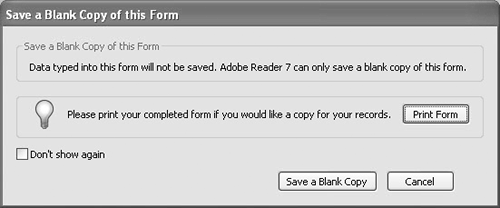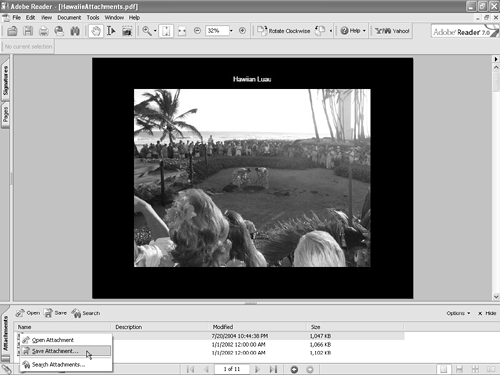One of the most common questions asked by Adobe Reader users is, why can't I save the edits I make on PDF files using Adobe Reader? Actually, you can save files, but only in limited circumstances.
Adobe Reader 7 offers you two ways of saving files. You normally can't edit PDFs, and therefore can't save the files. You can, however, save a copy of a PDF document for the purpose of duplicating the file and saving the PDF from within a Web browser.
The second way of saving a PDF is when the document has been enabled with usage rights for Adobe Reader users. In this case, you can edit and then save the file in Adobe Reader, just as you would expect to save a document in Adobe Acrobat.
When you save a copy of a PDF document you are essentially duplicating the original file. Any data you add or editing you do in the PDF in Adobe Reader is not saved with the copy. This Adobe Reader feature is intended for those who view files in Web browsers and who want to save a copy to their hard drive when the option to download the PDF is unavailable. Additionally, when you view PDFs from CD-ROMs or network servers, you can use the Save a Copy command to save the file from another source to your hard drive.
To save a copy of a PDF document:
Open a PDF file in Adobe Reader.
Select File > Save a Copy, press Shift+Ctrl/Command+S, or click the Save a Copy tool in the File toolbar.
Before the Save a Copy dialog opens, a warning dialog appears (Figure 10.1) informing you that the document does not allow any changes and that only a copy of the original, unedited version will be saved. Click OK.
The Save a Copy dialog opens. Type a name for the file in the File name (Windows shown in Figure 10.2) or the Save As (Macintosh) text box. Browse your hard drive to locate a target folder and then click Save.
A duplicate of the original file is saved to disk.
The one circumstance in which you can save an updated document is when the PDF file is enabled with usage rights. Adobe Acrobat 7 Professional users can enable PDFs with usage rights for the purposes of comment and markup. Enterprises may use the affordable Adobe LiveCycle Reader Extensions to add usage rights for saving form data and adding digital signatures in addition to adding comment and markup. When any of these usage rights have been added to a PDF file, both a Save command and a Save As command appear in the File menu.
Note
If you don't have a file with usage rights enabled, use the hawaiiNewsletter.pdf file from www.peachpit.com/adobereader7.
To save a file from Adobe Reader:
Open a PDF document that's been enabled with usage rights for Adobe Reader, or open the hawaiiNewsletter.pdf document. Note: If the file you open doesn't have usage rights enabled, the Save command won't appear in the File menu.
Make your edits to the document. If the file is enabled for comment and markup, try adding a comment to the file.
Select File > Save or press Ctrl/Command+S. The file is updated. Note that no dialog opens when you select the Save command.
When you add data to PDF files, such as making comment notes, Adobe Reader keeps track of all your edits. If you add a note and delete it, the deletion doesn't return the document to its original file size. As a result, the file size tends to swell more than needed to preserve all the data. When you use the Save command, you're saving that oversized file.
As an alternative, you can rewrite the file to disk and eliminate any redundant data, producing a smaller, optimized file. To do this, use the Save As command.
To optimize files enabled with Adobe Reader usage rights:
Open a file in Reader for which usage rights have been enabled, or use the hawaiiNewsletter.pdf file.
Make an edit in the document such as adding a comment note.
Open the Preferences dialog by pressing Ctrl/Command+K.
Click General in the left pane.
Check the box for Save As optimizes for Fast Web View (Figure 10.4). By default the item should be checked in the General preferences. If it's not, check the box. This option optimizes your file each time you use the Save As command.
Select File > Save As. By default the target folder is the same location where you opened the original document. Click Save in the Save As dialog, and a warning dialog appears informing you that the file already exists and asking whether you want to replace the existing file.
Click Yes in the Save As warning dialog (Figure 10.5). Adobe Reader overwrites the PDF document and optimizes it for the smallest file size.
You can invoke an autosave option for files with Adobe Reader usage rights enabled so that you can autosave the updates. In the event you make copious comments in a session and you want to guard against computer failure or a power outage, you can have Adobe Reader routinely save your edits at intervals you define.
To enable the autosave feature:
Open the Preferences dialog by pressing Ctrl/Command+K.
Click General in the left pane.
Check the Automatically save document changes to temporary file every box.
Type an interval value in the text box adjacent to the text (Figure 10.9). You can specify an interval from 1 to 99 minutes.
Click OK in the Preferences dialog. Each time you open Adobe Reader, the new preferences settings become the default for autosaving files.
Sometimes you might edit a document and then want to discard all the edits you made during that Adobe Reader session. Before saving a document, you can use the Revert command to revert to the last saved version of your document. This command appears only when you're working on PDFs enabled with usage rights for Adobe Reader.
To revert to the last saved version of a document:
Open a PDF document enabled with usage rights in Adobe Reader or use the hawaiiNewsletter.pdf file.
If the usage rights are established for comment and markup, add a comment to the document.
Select File > Revert (Figure 10.10). The original file appears in the Document pane. Even though you may have the autosave preferences enabled, the Revert command opens the last version of the file you saved with either the Save or the Save As command and ignores all recently saved versions that were created with the autosave feature.
A file attachment is a file of any type, even another PDF document, that's attached to a PDF document. When you open a PDF file containing an attachment, you can save the attached file to disk.
Viewing and saving file attachments from a PDF doesn't require any special usage rights. But if you want to attach a file to a PDF document in Adobe Reader, the PDF must have usage rights enabled. Acrobat Standard and Professional users, however, can attach files and save attachments without any special usage rights.
Note
If you don't have a file with an attachment, you can download and use the acrobatTips.pdf file from www.peachpit.com/adobereader7. The file is secure, so in the Password dialog, type: password.
To save file attachments to your hard drive as separate files:
Open a PDF file containing file attachments or use the acrobatTips.pdf file.
If the Attachments pane isn't open, click the Attachments tab.
Open a context menu on a file attachment and select Save Attachment (Figure 10.11).
The Save Attachment dialog opens. The dialog has the same attribute choices as you find in the Save and Save As dialogs. Type a name for the file and select a target folder. Click Save, and the attachment is saved as a separate file apart from the PDF document.










